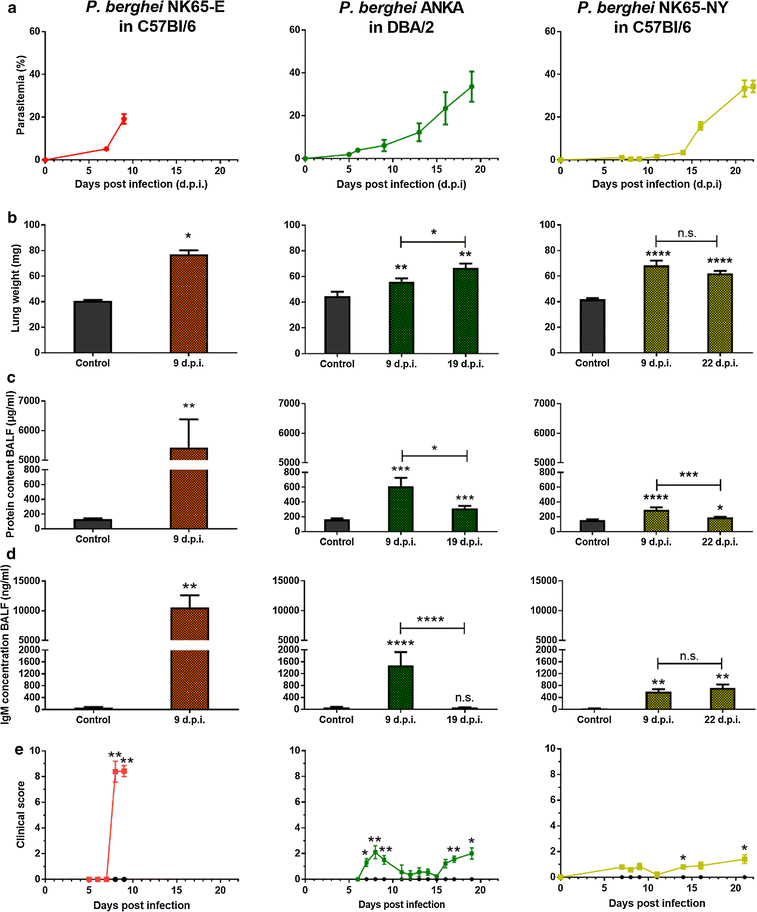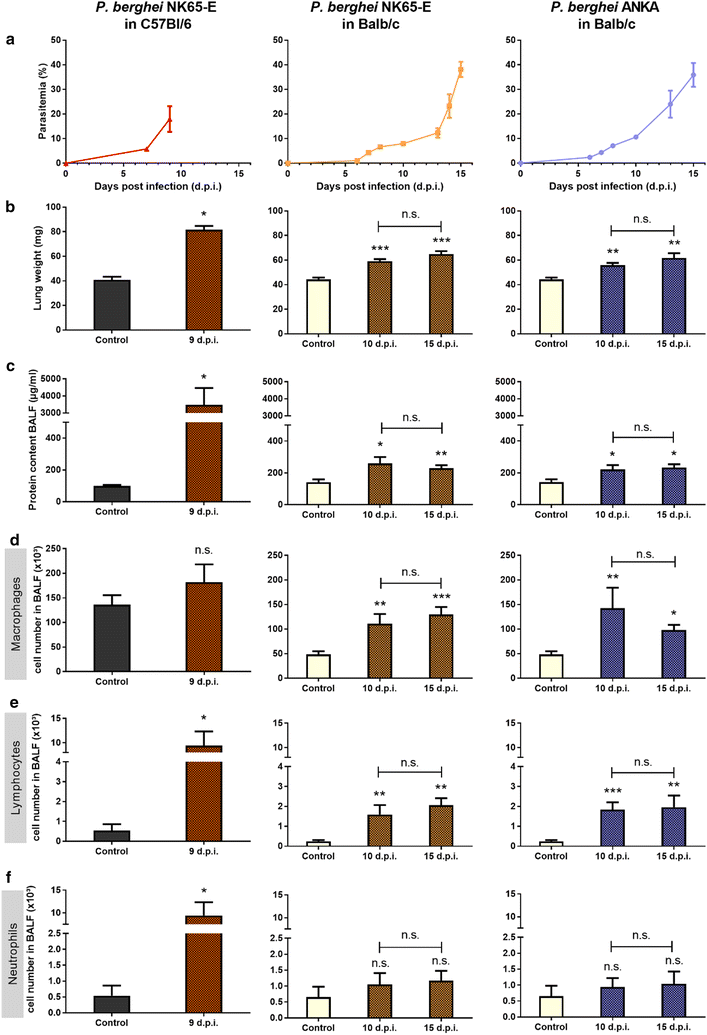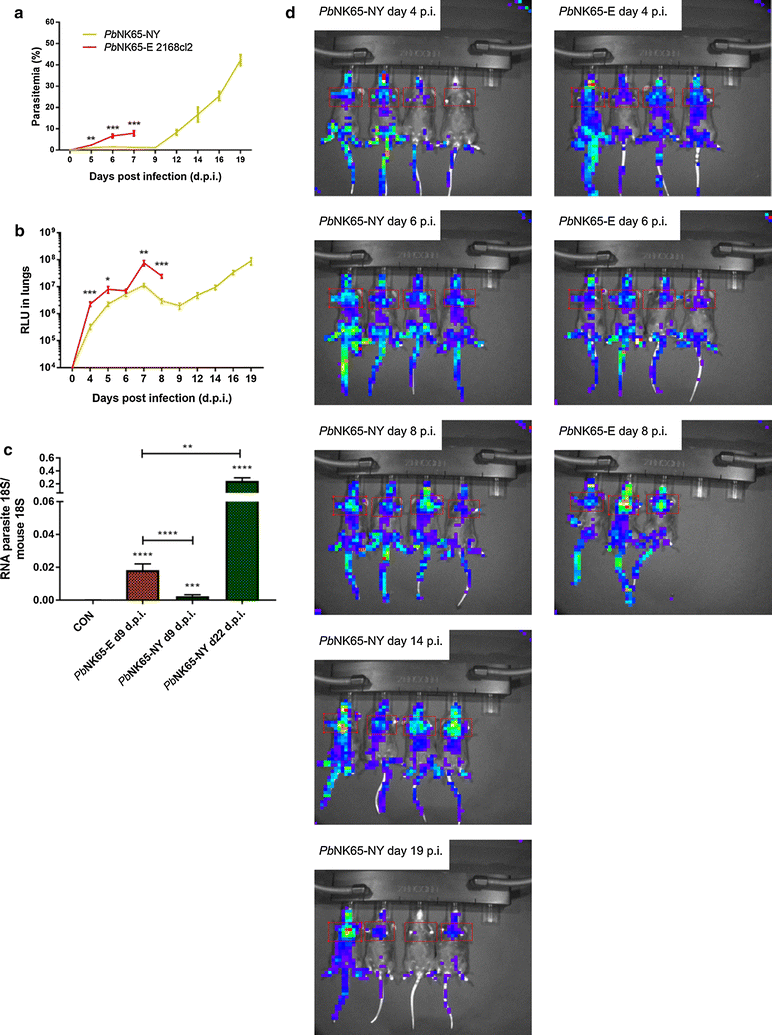Experimental malaria-associated acute respiratory distress syndrome is dependent on the parasite-host combination and coincides with normocyte invasion
- PMID: 29506544
- PMCID: PMC5839036
- DOI: 10.1186/s12936-018-2251-3
Experimental malaria-associated acute respiratory distress syndrome is dependent on the parasite-host combination and coincides with normocyte invasion
Abstract
Background: Malaria-associated acute respiratory distress syndrome (MA-ARDS) is a complication of malaria with a lethality rate of up to 80% despite anti-malarial treatment. It is characterized by a vast infiltration of leukocytes, microhaemorrhages and vasogenic oedema in the lungs. Previously, a mouse model for MA-ARDS was developed by infection of C57BL/6 mice with the Edinburgh line NK65-E of Plasmodium berghei.
Results: Here, both host and parasite factors were demonstrated to play crucial roles in the development and severity of lung pathology. In particular, the genetic constitution of the host was an important determinant in the development of MA-ARDS. Both male and female C57BL/6, but not BALB/c, mice developed MA-ARDS when infected with P. berghei NK65-E. However, the New York line of P. berghei NK65 (NK65-NY) did not induce demonstrable MA-ARDS, despite its accumulation in the lungs and fat tissue to a similar or even higher extent as P. berghei NK65-E. These two commonly used lines of P. berghei differ in their red blood cell preference. P. berghei NK65-NY showed a stronger predilection for reticulocytes than P. berghei NK65-E and this appeared to be associated with a lower pathogenicity in the lungs. The pulmonary pathology in the C57BL/6/P. berghei NK65-E model was more pronounced than in the model with infection of DBA/2 mice with P. berghei strain ANKA. The transient lung pathology in DBA/2 mice infected with P. berghei ANKA coincided with the infection phase in which parasites mainly infected normocytes. This phase was followed by a less pathogenic phase in which P. berghei ANKA mainly infected reticulocytes.
Conclusions: The propensity of mice to develop MA-ARDS during P. berghei infection depends on both host and parasite factors and appears to correlate with RBC preference. These data provide insights in induction of MA-ARDS and may guide the choice of different mouse-parasite combinations to study lung pathology.
Keywords: Lung; Malaria-associated acute respiratory distress syndrome; Normocyte; Plasmodium berghei; Reticulocyte.
Figures







Similar articles
-
Experimental Models to Study the Pathogenesis of Malaria-Associated Acute Respiratory Distress Syndrome.Front Cell Infect Microbiol. 2022 May 23;12:899581. doi: 10.3389/fcimb.2022.899581. eCollection 2022. Front Cell Infect Microbiol. 2022. PMID: 35677654 Free PMC article. Review.
-
Altered Lipid Composition of Surfactant and Lung Tissue in Murine Experimental Malaria-Associated Acute Respiratory Distress Syndrome.PLoS One. 2015 Dec 1;10(12):e0143195. doi: 10.1371/journal.pone.0143195. eCollection 2015. PLoS One. 2015. PMID: 26624290 Free PMC article.
-
Differential induction of malaria liver pathology in mice infected with Plasmodium chabaudi AS or Plasmodium berghei NK65.Malar J. 2018 Jan 9;17(1):18. doi: 10.1186/s12936-017-2159-3. Malar J. 2018. PMID: 29316914 Free PMC article.
-
Immunopathology and dexamethasone therapy in a new model for malaria-associated acute respiratory distress syndrome.Am J Respir Crit Care Med. 2010 May 1;181(9):957-68. doi: 10.1164/rccm.200905-0786OC. Epub 2010 Jan 21. Am J Respir Crit Care Med. 2010. PMID: 20093644
-
An alternative approach to malaria vaccine with a permanent attenuated mutant from a high virulence Plasmodium berghei strain.Zentralbl Bakteriol Mikrobiol Hyg A. 1987 May;264(3-4):319-25. Zentralbl Bakteriol Mikrobiol Hyg A. 1987. PMID: 3310458 Review.
Cited by
-
Experimental Models to Study the Pathogenesis of Malaria-Associated Acute Respiratory Distress Syndrome.Front Cell Infect Microbiol. 2022 May 23;12:899581. doi: 10.3389/fcimb.2022.899581. eCollection 2022. Front Cell Infect Microbiol. 2022. PMID: 35677654 Free PMC article. Review.
-
Aspecific binding of anti-NK1.1 antibodies on myeloid cells in an experimental model for malaria-associated acute respiratory distress syndrome.Malar J. 2024 Apr 18;23(1):110. doi: 10.1186/s12936-024-04944-9. Malar J. 2024. PMID: 38637828 Free PMC article.
-
CCR2 Is Dispensable for Disease Resolution but Required for the Restoration of Leukocyte Homeostasis Upon Experimental Malaria-Associated Acute Respiratory Distress Syndrome.Front Immunol. 2021 Feb 16;11:628643. doi: 10.3389/fimmu.2020.628643. eCollection 2020. Front Immunol. 2021. PMID: 33664739 Free PMC article.
-
Skeleton binding protein-1-mediated parasite sequestration inhibits spontaneous resolution of malaria-associated acute respiratory distress syndrome.PLoS Pathog. 2021 Nov 29;17(11):e1010114. doi: 10.1371/journal.ppat.1010114. eCollection 2021 Nov. PLoS Pathog. 2021. PMID: 34843584 Free PMC article.
-
Brain endothelial STING1 activation by Plasmodium-sequestered heme promotes cerebral malaria via type I IFN response.Proc Natl Acad Sci U S A. 2022 Sep 6;119(36):e2206327119. doi: 10.1073/pnas.2206327119. Epub 2022 Aug 29. Proc Natl Acad Sci U S A. 2022. PMID: 36037380 Free PMC article.
References
-
- WHO. World malaria report 2016. Geneva: World Health Organization; 2016. http://www.who.int/malaria/publications/world-malaria-report-2016/report....
MeSH terms
Grants and funding
LinkOut - more resources
Full Text Sources
Other Literature Sources
Medical

